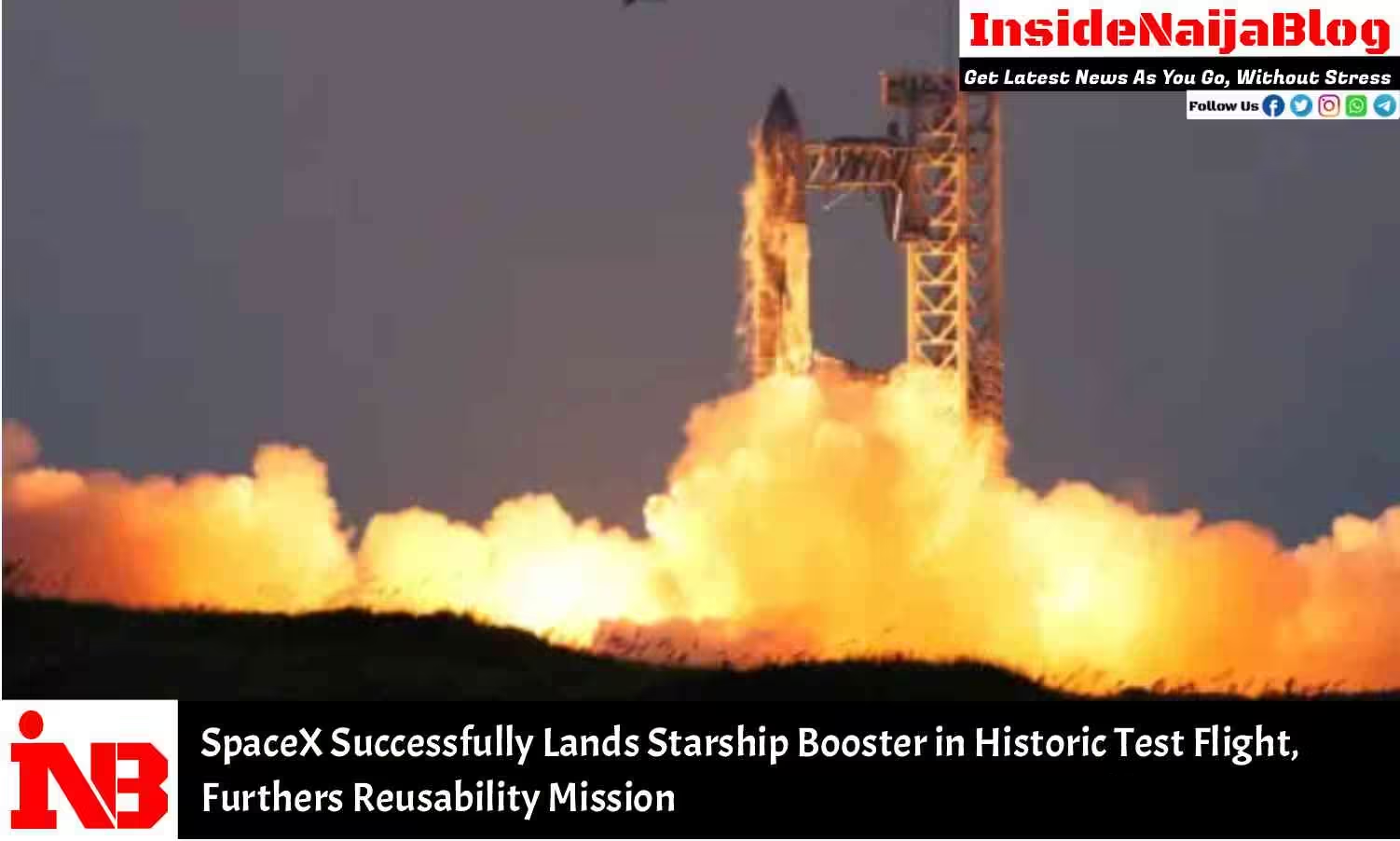In a groundbreaking achievement for space exploration, SpaceX successfully flew and landed the first-stage booster of its colossal Starship rocket back to its launch pad in Texas, marking a significant step in the company’s pursuit of rapid rocket reusability. The mission, which took place on Sunday, saw the uncrewed Starship rocket launch into the sky, followed by a controlled descent of the “super heavy booster” back to its starting point—a technical feat that thrilled SpaceX engineers and space enthusiasts alike.
The booster, which had been attached to the lower part of the Starship rocket, returned to Earth after just a few minutes in flight. In a demonstration of precision engineering, the booster descended toward the launch pad, where enormous mechanical arms, known as “chopsticks,” reached out from the launch tower to gently catch and secure it. This moment, captured on a livestream by SpaceX, showcased the company’s growing capability to recover and reuse its rockets, which could drastically reduce the cost of space travel.
The upper stage of the Starship rocket, after completing its own part of the mission, successfully splashed down in the Indian Ocean as planned. Elon Musk, CEO of SpaceX, expressed his satisfaction with the mission’s success, sharing on his social media platform X, “Ship landed precisely on target!” He noted that two key objectives of the test flight had been met: the successful return of both the booster and upper stage of Starship.
A Historic Moment for SpaceX
SpaceX employees erupted in cheers as the booster was caught by the launch tower’s “Mechazilla” arms—a nickname Musk has given the mechanical structure. The smooth landing of the booster marks an engineering milestone for SpaceX, solidifying its path toward achieving fully reusable rocket systems.
“This is a day for the engineering history books,” a SpaceX spokesperson declared during the livestream. Liftoff took place at 7:25 a.m. (1225 GMT) from the company’s southern Texas facility under clear skies, offering ideal conditions for the test flight.
The success of Sunday’s flight comes after years of preparation and months of testing by SpaceX engineers, who meticulously worked on the complex systems that made the booster landing possible. According to the company, technicians logged tens of thousands of hours building the necessary infrastructure and ensuring every component of the rocket and the launch tower was finely tuned to execute the maneuver flawlessly.
Had conditions not been optimal for the booster’s return, SpaceX had planned for it to splash down in the Gulf of Mexico, a procedure used in previous tests. However, thanks to favorable conditions, the booster was able to decelerate from supersonic speeds, guided by its powerful engines, and land safely at the pad.
The Road to Reusability and Beyond
The Starship system, comprising both the Super Heavy booster and Starship upper stage, stands a towering 397 feet tall, making it the largest rocket ever built. The Super Heavy booster alone measures 233 feet and generates a staggering 16.7 million pounds of thrust—double that of the Saturn V rockets used in the Apollo missions. The sheer scale and power of Starship make it a key component of SpaceX’s ambition to not only explore the Moon and Mars but also to revolutionize space travel through reusability.
SpaceX’s iterative approach to rocket development, which Musk describes as a “fail fast, learn fast” strategy, has allowed the company to quickly improve its technology, even when early tests have resulted in dramatic failures. This aggressive testing regimen has helped SpaceX leap ahead of established aerospace giants, and today, the company leads the world in orbital launches.
SpaceX’s achievements extend beyond rocket development. The company has created the largest satellite constellation in the world, providing crucial internet access in remote and war-torn regions. In addition, its Crew Dragon spacecraft is currently the only American spaceship certified to carry astronauts to the International Space Station, a milestone in human spaceflight.
NASA and the Future of Space Exploration
NASA, which has been closely following SpaceX’s advancements, congratulated the company on the success of its test flight. The space agency has a vested interest in Starship’s development, as a modified version of the spacecraft is slated to serve as a lunar lander for its Artemis program. NASA aims to send astronauts back to the Moon later this decade, using Starship to carry crew members to the lunar surface.
Sunday’s successful test brings SpaceX one step closer to achieving the dream of making space travel more efficient, affordable, and accessible. Musk has long stated his goal of making humanity a multiplanetary species, with Mars as the ultimate destination. The reusability of rockets like Starship is a key part of that vision, as it could dramatically reduce the cost of launching heavy payloads into space and make long-term missions to other planets more feasible.
Political and Regulatory Challenges Ahead
Despite these successes, SpaceX faces some challenges on the political and regulatory front. Musk’s growing association with right-wing political figures, including former U.S. President Donald Trump, has raised eyebrows in some circles. Musk recently appeared alongside Trump at a rally in Pennsylvania, wearing an “Occupy Mars” T-shirt, sparking speculation about his political leanings.
At the same time, SpaceX has been involved in a public dispute with the Federal Aviation Administration (FAA) over launch regulations. Musk has accused the agency of overreach and has even called for the resignation of its chief, Michael Whitaker, as he seeks to minimize regulatory interference with SpaceX’s activities, particularly as the company ramps up its launch schedule.
Some analysts believe Musk is positioning SpaceX for a more favorable regulatory environment should Trump return to the White House. However, it remains to be seen how these political maneuvers will impact SpaceX’s operations, especially given the company’s reliance on government contracts and partnerships with agencies like NASA.
For now, however, SpaceX’s focus remains firmly on advancing its technology, with each successful test bringing humanity closer to an era where space travel becomes routine.




